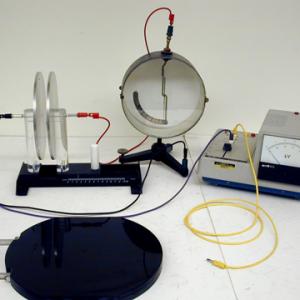College of Liberal Arts & Sciences
5C20.10 - Dielectrics
Video Credit: Jonathan M. Sullivan-Wood
Hook the sliding plate capacitor to the electroscope, charge the plates with the high voltage power supply to 3000 Volts as read on the electroscope. Insert the dielectric between the capacitor plates and observe the voltage drop to approximately 1500 Volts. Removing the dielectric should return the voltage to close to its original value. The aluminum plate can also be used and thought of in terms of being the perfect dielectric.
NOTE: At these voltages the dielectric can touch the sliding capacitor plates with negligible effects.
These dielectrics should give these approximate voltage drops:
Halliday and Resnick textbook = 1000 to 1500 volts
Round Phenolic 1" Plate - 1500 volts
Mica = 500 volts
Cardboard = 300 to 500 volts
Thin smooth phenolic sheet = 500 volts
Thick rough phenolic sheet = 1000 volts
- Youngmin Oh, Taehun Jang, Hyejin Ha, Sangho Sohn, "Temporal Change of a Parallel Plate Capacitor's Voltage After Dielectric Insertion", TPT, Vol. 60, #2, Feb. 2022, p. 124.
- T. T. Grove and M. F. Masters, "Simply and Accurately Measuring Dielectric Constants Using a Parallel Plate Capacitor: Sometimes You Just Can't Win", TPT, Vol. 47, #5, May 2009, p. 312.
- Paul Gluck, "Force on the Dielectric in a Parallel Plate Capacitor", TPT, Vol. 41, #9, Dec. 2003, p. 521.
- Steven D. Doty and Sandra L. Doty, "Dielectric Breakdown of Air as Order-of-Magnitude Physics", TPT, Vol. 36, #1, Jan. 1998, p. 6.
- Edwin A. Karlov, "Let’s Measure the Dielectric Constant of a Piece of Paper!", TPT, Vol. 29, #1, Jan. 1991, p. 23.
- Ellis D. Noll, "Measuring Capacitance and the Dielectric Constant", TPT, Vol. 26, #3, Mar. 1988, p. 169.
- S. K. Chakarvarti, "Permittivity of Free Space and Dielectric Constant Measurement", TPT, Vol. 19, #2, Feb. 1981, p. 120.
- Oleg D. Jefimenko and David K. Walker, "Electrets", TPT, Vol. 18, #9, Dec. 1980, p. 651.
- John W. Hammann, "Characteristics and Nature of Dielectrics", TPT, Vol. 3, #8, Nov. 1965, p. 354.
- "Little Stinkers: Change of Energy of a Charged Capacitor", TPT, Vol. 2, #3, Mar. 1964, p. 137.
- Bart H. McGuyer, "Frequency-Dependent Capacitors Using Paper", AJP, Vol. 89, #4, April 2021, p. 370.
- T. T. Grove, M. F. Masters, and R. E. Miers, "Determining Dielectric Constants Using a Parallel Plate Capacitor", AJP, Vol. 73, #1, Jan. 2005, p. 52.
- Eric R. Dietz, "Force on a Dielectric Slab: Fringing Field Approach", AJP, Vol. 72, #12, Dec. 2004, p. 1499.
- Constantino A. Utreras‐Díaz, "Dielectric Slab in a Parallel-Plate Condenser", AJP, Vol. 56, #8, Aug. 1988, p. 700.
- A. Gingle and T. M. Knasel, "Undergraduate Laboratory Investigation of the Dielectric Constant of Ice", AJP, Vol. 43, #2, Feb. 1975, p. 161.
- Francis T. Worrell, "An Experiment on the Dielectric Constant of a Gas", AJP, Vol. 22, #6, Sept. 1954, p. 375.
- Yaakov Kraftmakher, "5.7, Dielectric Constant", Experiments and Demonstrations in Physics, ISBN 981-256-602-3, p. 343.
- W. Bolton, "31. The Permittivity of Free Space", Book 4 - Electricity, Physics Experiments and Projects, 1968, p. 59 - 61.
Disclaimer: These demonstrations are provided only for illustrative use by persons affiliated with The University of Iowa and only under the direction of a trained instructor or physicist. The University of Iowa is not responsible for demonstrations performed by those using their own equipment or who choose to use this reference material for their own purpose. The demonstrations included here are within the public domain and can be found in materials contained in libraries, bookstores, and through electronic sources. Performing all or any portion of any of these demonstrations, with or without revisions not depicted here entails inherent risks. These risks include, without limitation, bodily injury (and possibly death), including risks to health that may be temporary or permanent and that may exacerbate a pre-existing medical condition; and property loss or damage. Anyone performing any part of these demonstrations, even with revisions, knowingly and voluntarily assumes all risks associated with them.
